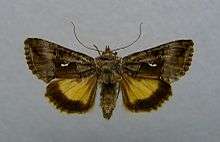Syngrapha microgamma
Syngrapha microgamma (little bride looper moth) is a moth of the family Noctuidae. It is found in much of Canada south in the east to southern Maine, northern New York, and the Great Lakes States. In Europe, it is found from Fennoscandia and central Europe east to mountains eastern Asia.
| Syngrapha microgamma | |
|---|---|
 | |
| Scientific classification | |
| Kingdom: | Animalia |
| Phylum: | Arthropoda |
| Class: | Insecta |
| Order: | Lepidoptera |
| Superfamily: | Noctuoidea |
| Family: | Noctuidae |
| Genus: | Syngrapha |
| Species: | S. microgamma |
| Binomial name | |
| Syngrapha microgamma (Hübner, [1823]) | |
| Synonyms | |
| |
The wingspan is 26–30 mm (1.0–1.2 in). Adults are on wing from May to July depending on the location. There is one generation per year.
The larvae feed on Ledum groenlandicum, Betula nana, Salix repens, Vaccinium uliginosum and Ledum palustre.
Subspecies
- Syngrapha microgamma microgamma (Fennoscandia, Baltia, Poland, north European Russia, central Asia (mountains), Kamchatka)
- Syngrapha microgamma nearctica (Labrador, Quebec to Yukon, Michigan, Wisconsin, Alberta, British Columbia, Colorado)
gollark: Yes.
gollark: More great "WHY WOULD YOU DO THIS":```go// A Context carries a deadline, cancelation signal, and request-scoped values// across API boundaries. Its methods are safe for simultaneous use by multiple// goroutines.type Context interface { // Done returns a channel that is closed when this Context is canceled // or times out. Done() <-chan struct{} // Err indicates why this context was canceled, after the Done channel // is closed. Err() error // Deadline returns the time when this Context will be canceled, if any. Deadline() (deadline time.Time, ok bool) // Value returns the value associated with key or nil if none. Value(key interface{}) interface{}}```
gollark: Basically, modems/rednet but more flexible, cross-server, and without actual modems.
gollark: It's a websocket-based inter-computer cross-server message relay.
gollark: ```rust#[derive(Serialize, Deserialize, Debug, PartialEq, Eq, Hash, Clone)]#[serde(untagged)]pub enum Channel { Numeric(i64), Named(String)}#[derive(Serialize, Deserialize, Debug, Clone, Message)]pub struct RawMsg { pub channel: Channel, #[serde(flatten)] pub meta: HashMap<String, Value>, pub message: Value}#[derive(Serialize, Deserialize, Debug, Clone, Message)]pub struct Msg { pub channel: Channel, #[serde(flatten)] pub meta: HashMap<String, Value>, pub message: Value, pub timestamp: chrono::DateTime<chrono::Utc>}#[derive(Serialize, Deserialize, Debug)]#[serde(tag = "type")]enum MessageFromClient { #[serde(rename = "open")] Open { channel: skynet::Channel }, #[serde(rename = "close")] Close { channel: skynet::Channel }, #[serde(rename = "message")] Message(skynet::RawMsg)}#[derive(Serialize)]#[serde(tag = "type")]enum MessageToClient<'a> { #[serde(rename = "message")] Message(skynet::Msg), #[serde(rename = "channels")] OpenChannels { channels: &'a HashSet<skynet::Channel> }}```WIP Rust notreallyconversion of the Skynet protocol.
This article is issued from Wikipedia. The text is licensed under Creative Commons - Attribution - Sharealike. Additional terms may apply for the media files.